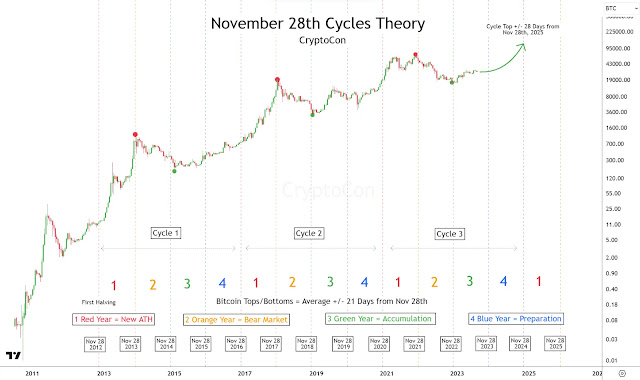Bitcoin Price Drops, but November 28th Cycles Theory Stays Resilient:
What You Need to Know
Bitcoin is a digital currency that was created in 2009. It is decentralized, meaning that it is not subject to government or financial institution control. Bitcoin is secured by cryptography, and its supply is limited to 21 million coins.
The Bitcoin cycle theory is a hypothesis about the price movements of Bitcoin. It states that the price of Bitcoin tends to follow a predictable pattern after each halving event. A halving event is when the reward for mining a new block of Bitcoin is cut in half. This happens every 210,000 blocks, which is roughly every 4 years.
The Bitcoin cycle theory is based on the following observations:
The price of Bitcoin tends to increase in the year leading up to a halving event.
The price of Bitcoin tends to peak shortly after a halving event.
The price of Bitcoin tends to decline in the two years following a halving event.
The price of Bitcoin tends to recover in the fourth year after a halving event.
The Bitcoin cycle theory is not without its critics. Some argue that the theory is based on too few data points to be reliable. Others argue that the theory is too simplistic and does not take into account other factors that could affect the price of Bitcoin, such as changes in regulations or the overall economic climate.
Despite the criticisms, the Bitcoin cycle theory has been relatively accurate so far. The price of Bitcoin has followed the predicted pattern after each of the last three halving events. However, it is important to remember that the Bitcoin market is volatile and unpredictable. The price of Bitcoin could go up or down sharply at any time, regardless of the Bitcoin cycle theory.
The November 28th Cycles Theory
The November 28th Cycles Theory is a variation of the Bitcoin cycle theory. The theory states that the price of Bitcoin tends to follow a predictable pattern after each halving event, with the following four phases:
Tops: come +/- 21 days from Nov 28th end of Red Year (red dot)
Bottoms: come +/- 21 days from Nov 28th end of Orange Year. (green dot)
Red Year (New ATH): New all-time highs are made in the year, and the cycle top forms at the end of the year.
Orange Year (Bear Market): Price cools down from its overvaluation and becomes undervalued at a new market bottom.
Green Year (Accumulation): The best buying prices of the cycle take place. Price moves towards the median price (half of previous ATH).
Blue Year (Preparation): Price establishes time around the median and makes an advance towards new all-time highs at the end of the year.
The November 28th Cycles Theory has been relatively accurate so far. It called the 2022 bottom after its creation, and it also successfully called the best cycle buying prices thus far.
The current year is the green year of the current cycle. The price of Bitcoin is still below the median price, but it has come close. The theory suggests that this is the best time to buy Bitcoin before the price starts to rise again.
Of course, the Bitcoin market is volatile and unpredictable. The price of Bitcoin could go up or down sharply at any time, regardless of the November 28th Cycles Theory. However, the theory is a useful tool for understanding the price movements of Bitcoin and making informed investment decisions.
The Theory's Track Record:
One of the remarkable aspects of the November 28th Cycles Theory is its historical accuracy. It successfully predicted the bottom of the market in 2022, and it has consistently identified the best cycle buying prices. While the price has not yet reached the median ($34,500).
For investors, this phase of the Green Year could be the last opportunity to invest at attractive prices outside of the cycle bottom. It's a time when accumulation takes precedence, and those with a long-term perspective can find excellent entry points.
the November 28th Cycle Theory may hold true for the current Bitcoin cycle and anticipates an early top of around $90,000 by April 2024, followed by a mid-cycle bear market. The final peak, predicts, could reach as high as $130,000 by late 2025.
However, it's essential to approach these predictions with caution. The cryptocurrency market is notorious for its volatility and unpredictability, and numerous external factors can influence Bitcoin's price.
Conclusion
The Bitcoin cycle theory is a useful tool for understanding the price movements of Bitcoin. However, it is important to remember that the Bitcoin market is volatile and unpredictable. The price of Bitcoin could go up or down sharply at any time, regardless of the Bitcoin cycle theory. Therefore, it is important to do your own research and understand the risks involved before investing in Bitcoin.




0 Comments